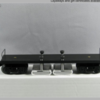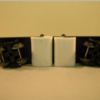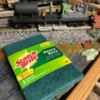There was, or have been, a couple threads(more than a couple lol) debating this topic. Especiallyin light of Lionel's 16-17 Track & Power magazine recommending a "Citrus based cleaner" as isopropyl alcohol doesn't help with "electrical conductivity" and MTH recommend "denatured alcohol"(Quotes from Lionel & MTH, respectively).
One night, I picked 9 random pieces of track that I use on my layout, and made 3 groups with each having a tubular piece and 2 realtrax pieces. For each group, I used gray, gritty type track eraser followed by the yellow track eraser found in Lionel maitenance packs. Wiped over with dry rag as, despite the claims, there was still "residue". Then...
Group 1: I applied 91% Isopropyl to 3 pieces with a soft rag, went over it with a scotch brite, and then used compressed air to finish the drying/get any other residue off.
Group 2: I applied denatured alcohol to 3 pieces with a soft rag and followed the same process as the Isopropyl
Group 3: Went over the track with a dry scotcchbrite pad. Applied track cleaner(I'll tell you the name in 20min when I go down to my layout) on a soft rag. Wiped off any excess with another rag and used compressed air to ensure the excess was gone. I then let it set over night as instructed.
The next day I went down and checked, I ended up going over Group 2 with Isopropyl alcohol as it left a film on the track. For group 3, there was a very light film on the track that i just got wipedd of with a rag and track eraser.
If you want to do a serious track cleaning for tubular- I suggest track eraser, dry scotchbrite, then apply 91% isopropyl with a scotchbrite pad,(if it's really dirty, go over the inner railswith a q-tip and the tp of the rails as well), make sure you clean the track pins as well andI'd suggest putting some type of conducta-lube ONLY on the track pins! Thendry off the track with a rag and compressed air.
Regarding denatured alcohol, I only use that to clean the wheels of my engines, specifically the wheels with traction tires as recomended by MTH b/c regular Isopropyl will dry out the neoprene.






















